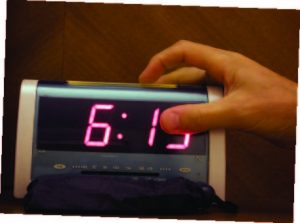News, views and insights on maintaining a healthy edge.
 Movers & (Salt) Shakers
Movers & (Salt) Shakers
Remember the row over Michael Bloomberg’s ban on super-sized sodas? Well, the Big Apple is now taking aim on sodium. New York’s Department of Health proposed that chain restaurants operating in the five boroughs add a salt-shaker icon to menu items that contain more than the recommended daily limit of 2,300 milligrams (roughly a teaspoon). “Studies show that those of us who consume higher amounts of sodium are more likely to develop hypertension, and those who already have high blood pressure are likely to develop heart problems and stroke as a result of higher sodium intake,” says

Michelle Ali, RD
Director, Food and Nutrition, Trinitas Regional Medical Center 908.994.5396
Michelle Ali, RD, Director of Food and Nutrition at Trinitas. You may not want to hear this (or you may know it already and don’t care) but every major chain has at least one delicious-sounding entrée that pushes past 3,000 mg of salt. And they aren’t always the obvious ones. Ali points out that, while most fruits and vegetables are naturally low in sodium, when they are prepared, sodium/salt is sometimes added to improve flavor. “Nutrition information is a tool that can guide consumers to make better food choices,” she says. “If a dish exceeds the recommended amount of sodium, move on to another food choice with less. Do portion control; take a portion home. Finally, add a salad, limit the dressing, and finish off with fresh fruit for dessert.” A final vote on the sodium “warning” should occur this September and the little shakers may be popping up on menus in time for the holiday season.
 Bum Deal for New Yorkers
Bum Deal for New Yorkers
What are those folks across the river up to these days? Not much, according to a study by NYU’s School of Medicine. According to findings published in the latest issue of Preventing Chronic Disease, the average New Yorker sits more than seven hours a day. The study involved 3,600 subjects who wore devices that monitored whether they were moving or sedentary during waking hours. The seven hours broke down to four during the day and three in the evening. Manhattanites actually logged eight hours on their fannies. The stats for men and women were equal. Trinitas Endovascular Surgeon

Ajay Dhadwal, MD RPVI
Endovascular Surgeon, Trinitas Regional Medical Center (Assistant Professor, Rutgers New Jersey Medical School) 973.972.9371
Ajay Dhadwal, MD RPVI, observes that the ill effects of a sedentary lifestyle influence almost every aspect of one’s health, from vascular disease in the blood vessels supplying the brain and the legs, to joint pains and obesity, to heart disease. “Endovascular surgeons often see conditions which, at their worst, can lead to stroke and eventual amputation of the legs,” he says. “Even a minimal increase in activity level can help reduce future risk, especially for those who smoke. For certain patients, regular walking can be as beneficial in the long term as stenting blood vessels of the leg in improving the distance they can walk. To see an overall positive impact, take the stairs more often or walk 20 minutes a day.”
 $150 Up in Smoke
$150 Up in Smoke
The Holy Grail for anti-tobacco groups is an idiot-proof way to stop smoking. Patches, gums and hypnotherapy are effective in some cases but not in others. A recent study of 2,500 smokers took a different approach and yielded some breathtaking results. The key ingredient was bribery. Subjects were divided into four groups and offered different types of financial incentives. Two groups were offered financial rewards for quitting. Two had to put their own cash on the line. Smokers who had to make a $150 deposit and stop smoking to get it back had a success rate twice as high as the first two groups. More revealing is that the $150 group had a success rate five times that of smokers who undergo traditional cessation programs.
 Nothing Rotten in the State of Denmark
Nothing Rotten in the State of Denmark
Allergy awareness in grade schools has been growing for a good two decades now. In some schools, the presence of a single peanut is enough to trigger a lockdown. But do school lunches actually have the potential to positively impact childhood allergies? A study published in the European Journal of Clinical Nutrition this summer attempted to answer this question. Nine Danish schools gave 3rd and 4th Graders their typical pre-packed lunches for three months, and then meals rich in fish, vegetables and fiber for another three months. At the end of each period, parents were asked to evaluate the status of their children’s asthma and/or allergies. The difference? None. Although undoubtedly healthier, the nutritionally balanced school lunches did not “perform” any better than the usual items the kids were eating when it came to allergies. Research on childhood allergies is critical, says

Kevin Lukenda, DO
Chairman, Family Medicine Department
908.925.9309
Dr. Lukenda, DO, Chairman of the Trinitas Family Medicine Department, even when the results are not headline-grabbing. “A child who experiences a full blown anaphylactic response to a food allergen can experience lifelong effects and anxieties,” he says. “This research doesn’t change the fact that having a peanut-free table or classroom can have a tremendous upside benefit for the student and their family, as it allows them to focus on school and not worry about a potentially life-threatening situation.”
 Link Between Heartburn & Heart Attacks
Link Between Heartburn & Heart Attacks
Back in June, acid reflux drugs were in the news after a study conducted by researchers at Stanford University and Houston Methodist Hospital showed a link between their use and an increased risk of heart attacks. The drugs in question are proton pump inhibitors (PPIs), which are among the most widely used and prescribed in the United States and are marketed under names such as Prilosec, Prevacid and Nexium. The researchers scanned the medical records of 2.9 million patients for key words like “heart attack” and found that they occurred at a rate 15 to 20 percent higher with people who used PPIs. The same correlation did not exist with patients who treated their acid reflux with H2 blockers, including Tagamet and Zantac. It’s worth noting that this is a highly unconventional approach to big data, and although the media grabbed it and ran, the medical community looks at the methodology with natural skepticism. This type of conclusion is typically the result of a randomized control trial, where PPIs would be compared to a placebo to see if the drug did actually produce the specific effect. On the other hand, the fact that H2 blockers did not show a heart attack link supports the idea that more research on PPIs is probably warranted. Until that happens, patients taking PPIs—whether prescribed or over the counter—should talk to their doctors before their next trip to the pharmacy.
 CBT Helping Insomniacs Hit the Snooze Button
CBT Helping Insomniacs Hit the Snooze Button
Recent findings published in Annals of Internal Medicine show that people with severe sleep issues can benefit from Cognitive Behavior Therapy (CBT). This conclusion was the result of an evidence review of 20 separate studies, and showed that insomniacs (individuals who have trouble sleeping for at least a month) who underwent CBT fell asleep 20 minutes faster and reduced the time they were awake once they fell asleep by a half hour. The data was generated by comparisons between groups that took sleeping pills and groups that underwent short sessions with therapists. The CBT group learned new strategies for falling asleep and staying asleep. A major component of CBT is stimulus control, which involves meditative exercises and relaxation techniques.
One interesting item that emerged is that getting out of bed and “hitting the reset button” is better than endless tossing and turning.

Anwar Y. Ghali, MD, MPA Chairman, Psychiatry 908.994.7454
Dr. Anwar Y. Ghali, MD, MPA, Chairman of Psychiatry at Trinitas, agrees that this strategy can help. “Patients who wake up in the middle of the night should not stay awake in bed for longer than about 30 minutes,” he says. “They should avoid keeping an eye on a watch or a clock, since that may interfere with the ability to go back to sleep. Leave the bed and engage in other activities until you feel sleepy again, then go back to bed. Don’t go to the refrigerator for a midnight snack. You may end up perpetuating the habit of getting up in the middle of the night for that trip to the refrigerator.”

Vipin Garg, MD
Director, Trinitas Comprehensive Sleep Disorders Center 908.994.8880
Dr. Vipin Garg, MD, Medical Director of the Trinitas Comprehensive Sleep Disorders Center, agrees that getting to sleep and staying asleep can become a matter of habit. “Many times, specialists in sleep medicine like me recommend sleep restriction technique for insomnia,” he says. “Patients are advised to get into the habit of a certain number of hours of sleep and maintain a certain bedtime and wake-up time. Once they are in this pattern, patients are advised to refrain from going to bed earlier than their normal time, even if they feel sleepy. Often, those who suffer from insomnia are shocked to hear this, since the common belief is that the more time you spend in bed, the more sleep you get. Sleep restriction therapy consolidates fragmented sleep to continuous and deeper sleep.”
For less severe cases of insomnia, there are a number of websites that can help (including calm.com), and the occasional intake of Rozerem or Silenor. However, given that insomnia has been linked to a wide range of health issues—including weight gain, depression, anxiety, heart disease and diabetes—and that sleeping pills aren’t a good long-term solution, chances are you’ll be hearing more and more about CBT and other sleep-related therapies.





